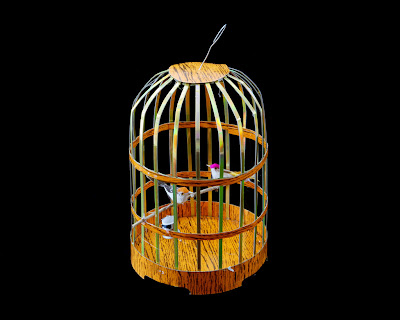Memorial monuments can mark and identify the resting place of our dead. They can bring an expression of the spirit of the deceased to a cemetery. They can also provide a focal point for survivors to continue their connection with their dead. From materials and artistic techniques to text and design, there are many ways to make these memorials meaningful. Among all the creative and beautiful memorials being created today, the work Greg Lundgren of Lundgren Monuments in Seattle stands out. He creates monuments out of cast glass. I'm pleased to be able to share a conversation with Mr. Lundgren here.
Patrick McNally: Personalization has been the
buzzword in funeral service for many years, but often the difference between a
personalized funeral or memorial and a standard one is minimal. We see markers and program folders with
photos instead of markers and folders without.
Often the difference seems akin to a blank t-shirt and a t-shirt with a
motorcycle or beach scene on it. Do you
think that your product is qualitatively different?
Greg Lundgren: I think what distinguishes Lundgren Monuments
is both product and service based. As an architectural glass designer, what I
brought forward into the industry, and what I fought for, was the introduction
of cast glass into the cemetery landscape. It required a lot of convincing,
educating the industry about the properties of cast glass, and placement of our
memorials in different climates around the world, before cemeteries stopped
viewing it with great suspicion, and more as an exciting, vibrant new medium.
So from a product sense, Lundgren Monuments really pioneered, and delivered an
expanded palate for designers to work with. From a services standpoint, we are
a custom design house, and I work very closely with my clients to develop
something original and one of a kind. I don't direct them to a catalog or a
cookie cutter inventory, and no idea is out of reach. I think it is
increasingly rare to work one-on-one with a designer that starts with a blank
sheet of paper. And where 90% of memorial designers are working exclusively
with stone, I design with bronze, stainless steel, granite and cast glass to
push the sculptural dimension and texture of a project. Five years ago I would
have said that it was large-scale cast glass, or maybe my modern aesthetic that
made our company unique, but much more than that it is the service we provide, the
close relationship between designer and client to craft something that really
is collaborative and special.
Patrick McNally: Monument companies often rely
upon a referral or a relationship with a funeral home or cemetery for much of
their business. In turn, there are too
many options for funeral directors or cemeterians to be able to share with
their clients in a limited amount of time.
Have you experienced successes
and setbacks in getting referrals? Is
your product unique enough to draw in a lot of direct business?
Greg Lundgren: Almost all of our business comes from working
directly with the family, and almost all of these families found us out of
sheer diligence and frustration with their local memorial dealer or funeral
home. Our clients share one common complaint, in that the choices they were
offered in more conventional settings were simply uninspired and ill-suited for
their loved one. We work with funeral homes and cemeteries all around the
world, but not typically through their referral. I wish it were more the case,
but most funeral homes and cemeteries have very exclusive contracts and
relationships with established granite dealers. And I don't believe they offer
enough options. If there were too many options, the cemetery landscape would
look like a sculpture park instead of a row of dominos. And I believe that
these long standing, very exclusive relationships between cemeteries, funeral
homes and granite dealers are bad for the cemetery and bad for the client. I
want to see the cemetery return to a position of cultural significance, to see
it once again harbor sculpture and diversity, and that can only happen by
diversifying the artists and mediums that are available to a family.
Patrick McNally: There is a great value to families in having
a meaningful and beautiful place to visit their dead. It seems to me that the more the family
connects to the memorial and site, the more they return, and the better able
they are to continue their relationship with their loved one in a meaningful way. What has your experience been with families
in the months after the monument has been installed?
Greg Lundgren: I agree completely. In order for cemeteries
to retain their cultural significance and attendance, they need to be beautiful
and serene landscapes. As an artist, I design all different types of things -
from cathedral windows to modern furniture, to custom memorials, and across the
board, working with a family on a memorial is the most satisfying process of
them all. And I imagine you would hear this from many designers working in the
funerary arts, but it is so rewarding to see the joy your work brings to the
grieving. I think cast glass is especially responsible for this because it
glows and holds a certain internal life force in it. So when families go to
visit their loved ones and see their memorial literally glow, shine bright in
the sunlight, it is pretty magical. And the light that activates our work does
make you smile, and does make you think that the person it memorializes must
have been very special. It is incredibly satisfying to hear from family and
friends after a work is installed, to hear their excitement about a memorial
that often reflects a great tragedy. And I suspect that is partly the power of
art in our culture - to inspire, to give hope, to shine a little light into the
darkness.
Patrick McNally: There seems to be a universal need for
survivors to memorialize their dead, and to have a permanent place to visit
them. Green cemeteries in the UK have
found that covenants forbidding individual markers may have appealed to the
deceased, but anger survivors. Families
who have scatted ashes often place a cenotaph in a place where they can visit
to feel connected to their dead.
Personalization often means that
we must share a sacred place with people whose aesthetic we do not share. Whether it is artificial flowers, gang
insignia, whirligigs, or gaudy markers, how do we reconcile our need to
interact with a grave, and our need to visit our dead in a place that we find
aesthetically pleasing?
Greg Lundgren: I think life in general requires great
tolerance and compassion. Humanity is eclectic and diverse and I think we
should really celebrate the individuality of a person. And while I believe that
cemeteries should rightfully have unique rules and regulations, I am a huge
proponent of sculptural diversity. Not just to allow glass, not just to push my
own personal aesthetics, but as recognition that we all hold different beliefs,
styles and expressions of our individuality. A cemetery memorial should reflect
the quirkiness of the person it marks. How absolutely boring it would be if all
the memorials looked the same, used the same granite color, the same font, and
made no allowance for humor or ego or self-expression. The fastest way to make
a cemetery irrelevant is to standardize the one last monument of the
individual. My absolute favorite cemeteries harbor this kind of sculptural
diversity, and I think that it is more of a selling point to a cemetery than a
detriment.
Patrick McNally: How long have you been
working with glass, and what led you to get into cemetery monuments?
Greg Lundgren: I have
been working as a professional glass designer for 16 years. I started designing
stained glass windows, and began doing more ambitious, larger scale projects.
Before too long I was casting glass, but mainly for architectural elements in
windows, doors, floors and furniture. My cast glass projects kept getting
heavier and thicker, and further away from our collective ideas about glass. We
live in a world surrounded by glass, but in fractions of an inch - like light
bulbs, window panes and wine glasses. But in thicknesses of an inch or more,
glass behaves a lot more like granite, and in many instances surpasses granite
as an exterior sculptural medium (it is non-corrosive, non-stainable,
non-porous, etc.) I was designing leaded glass windows for a new cemetery
chapel, and was driving through the cemetery grounds. And in front of me were
thousands of upright slabs of granite. As an architectural designer, granite
and cast glass had become interchangeable. So it didn't take much to imagine
big, glowing, colorful slabs of glass dotting that landscape. I guess you could
say my entry into cemetery monuments was very accidental, but I love
discovering dysfunctional systems and trying to improve them. And I find death
care in general to be a very important, very dysfunctional system.
Patrick McNally: How has your experience working
with families to create a memorial been different from working with other
clients?
Greg Lundgren: I've been a designer my entire adult life,
and have worked with a great variety of people, in a great variety of fields.
In some ways, designing memorials is no different than designing a theatre set
or a dining room table. You gather information, ask a lot of questions, define
a budget, propose a design, refine, and eventually go into fabrication. What
makes designing memorials so unique is the task of trying to marry the spirit
of a person to a sculptural form. And
how special the relationship is between designer and client. Memorials aren't
something people buy and re-sell, or collect like art or antiques. It is as
permanent as it gets and requires a great sense of trust. But the great majority of my clients are so
respectful and appreciative that it is much more satisfying than designing
furniture or other functional art. One memorial might not do much to change the
world, but it can play an incredible role in healing, honoring the ones we love
and changing the way we view and employ contemporary art.
Patrick McNally: Thank you for sharing your work and your thoughts with us. To find out more about Lundgren Monuments, visit the website http://www.lundgrenmonuments.com/ email at info@lundgrenmonuments.com, call 206.910.2432, or visit the offices at
Lundgren Monuments
1011 Boren Avenue
Seattle, WA 98104
To read an interview with Sigrid Herr, another outstanding monument artist, visit http://www.dailyundertaker.com/2010/07/art-of-remembering-conversation-with.html








































